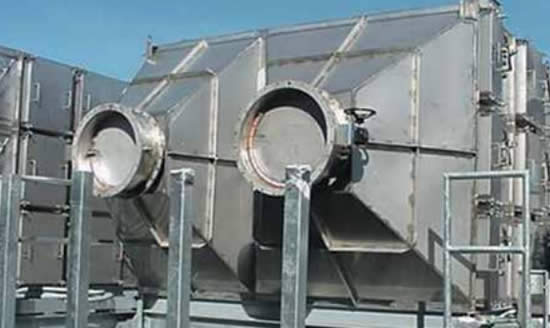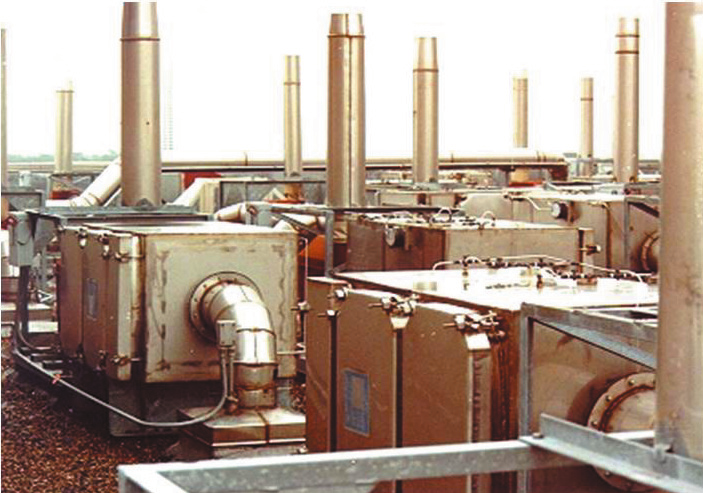Custom Containment Filtration Systems
Chemical • Biological • Radiological
Containment Filtration Systems for the Treatment of Contaminated Air Streams

In 1960, Barnebey Sutcliffe, now a Division of Continental Carbon, pioneered the use of special HVAC filter support systems for the nuclear power industry. These are now known as Containment Filtration Systems.
Containment Filtration Systems are installed wherever the air to be filtered contains the most hazardous chemical, biological or radiological contaminants. Containment Systems include special features for service and maintenance which provide greater safety for the operator by preventing the release of the contaminants into the air surrounding the system.
Containment Filtration System Construction
High-Efficiency Air Filtration
These systems provide high-efficiency air treatment greater than 99.9% contaminate removal, with provisions for safety during service. These features satisfy current requirements for a wide range of applications.
Filtration Elements
Filter elements installed in Containment Systems include particulate High-Efficiency Particulate Air (HEPA), Ultra-Low Penetration Air (ULPA) filters, activated carbon High-Efficiency Gas Adsorbers (HEGA) filters, and associated prefilters installed to increase the service life of downstream filters.
Filter Clamping Methods
Containment Systems are supplied with one of two alternative filter clamping methods:
Gasket Seal
Gasket Seal (CM Series) – a spring-loaded clamping mechanism that compresses the filter gasket providing a positive seal between the filter face and the sealing surface of the housing.
Knife-Edge Seal
Knife-Edge Seal (KE Series) – a clamping arm is designed to manually engage the filter element into a knife-edge flange. The seal is made when the knife-edge flange penetrates a gel-filled channel provided with the filter element.
Modular Design
The complete Containment System is constructed of modular sections that are factory assembled and tested to suit the demands of a specific application.
Typical System
A typical system consists of an inlet bubble-tight isolation damper (BTD), a prefilter with separate access, a housing section to accommodate a standard HEPA or HEGA filter, and an outlet BTD including pressure gauge assemblies and welded transitions. Typically, the housing is combined with a skid, fan, controls, instrumentation, etc., to form a complete “drop-in” system.

Design Quality & Features
- Time and application proven modular design.
- Safe and easy method to maintain filters without contaminating the area outside of the containment system.
- Available in two basic configurations: CM and KE series.
- Change up to three filters (placed in parallel) through a single access port.
- All housings are factory leak-tested to ASME N510 Testing of Nuclear Air Treatment Systems.
- Available for use in vertical or horizontal airflow applications.
- One-piece front panel and back panel construction of rugged 300 series stainless steel.
- Standard housings are designed to withstand 20″ w.g. positive and negative pressures.
Gasket Seal (CM Series) Features
- Accommodates standard gasketed HEPA or HEGA filters.
- A positive spring-loaded filter-locking echanism that applies constant pressure on each filter.
- The mechanism is operated from outside of the housing using standard tools.
- No special filter clip is required for filter removal.
- Clean-up of seal surfaces not required during filter change-out.
Knife Edge Seal (KE Series) Features
- Less clamping force required to maintain a proper seal.
- The filter access door cannot be reinstalled unless the filter latch is properly engaged.
Applications
Government Regulations require the protection of the Public against the discharge of chemical, biological, radioactive or nuclear contaminates into the air. Several applications require custom containment filtration systems in the following industries:
- Government Facilities
- Hospitals and Medical Research
- Chemical and Pharmaceutical Industry
- Military Installations
- Schools and Public Buildings
- University and Industrial Research Facilities
- Electronics and High Technology Industries
- Genetic Engineering




